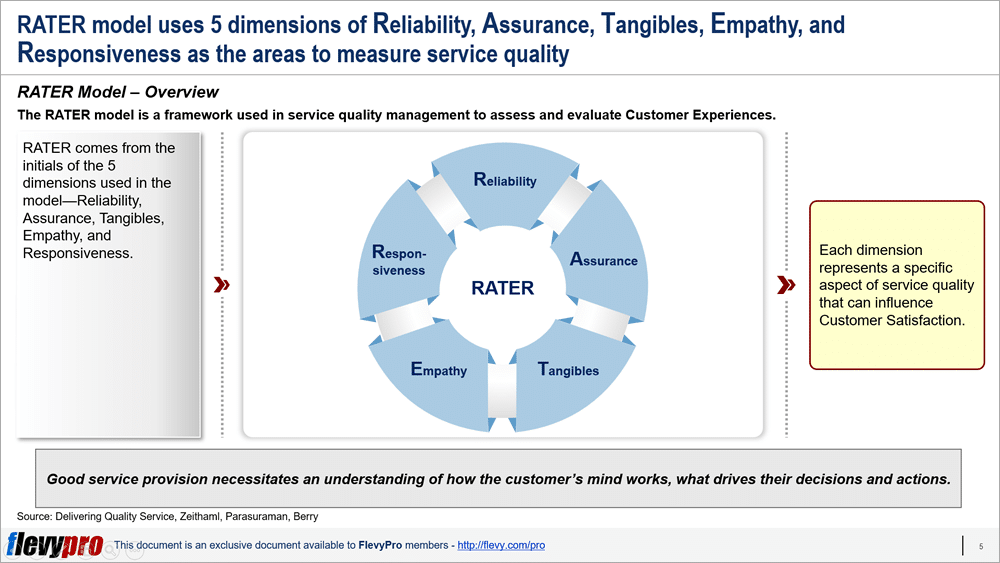Editor's Note: Take a look at our featured best practice, Digital Customer Service (DCS) (105-slide PowerPoint presentation). In this Digital Customer Service presentation, we navigate the evolving landscape of customer preferences, emphasizing the need for transformation in customer service to meet digital demands. We explore how digital experiences have shifted customer engagement and introduced Digital Customer [read more]
RATER Model
Also, if you are interested in becoming an expert on Customer-Centric Design (CCD), take a look at Flevy's Customer-Centric Design (CCD) Frameworks offering here. This is a curated collection of best practice frameworks based on the thought leadership of leading consulting firms, academics, and recognized subject matter experts. By learning and applying these concepts, you can you stay ahead of the curve. Full details here.
* * * *
Providing effective customer service necessitates comprehending how the customer’s mind works and what drives their choices or actions.
Measuring and improving service quality is crucial for enhancing Customer Satisfaction, Customer Loyalty, and overall business success. This involves collecting customer feedback, analyzing performance metrics, and implementing targeted strategies to enhance Customer Satisfaction and exceed their expectations.
Service quality management models aid in closing the perception gap between what businesses think they are providing to customers and what those customers expect, desire, or need through customer service.
The RATER model is a framework used in service quality management to assess and evaluate Customer Experiences. RATER comes from the initials of the 5 dimensions used in the model—Reliability, Assurance, Tangibles, Empathy, and Responsiveness.
Each dimension represents a specific aspect of service quality that can influence Customer Satisfaction.
RATER model is a useful tool for assessing and building quality service excellence.
The model has some limitations as well that need to be kept in mind while leveraging its benefits.
Some of the benefits of the RATER model include:
- Comprehensive assessment
- Customer-centric perspective
- Structured evaluation
- Identification of improvement areas
Organizations should be aware of the limitations of the RATER model and consider using it as part of a broader set of tools and methodologies to gain a comprehensive understanding of the Customer Experience. Drawbacks include:
- Subjectivity
- Lack of context
- Limited scope
- Implementation challenges
RATER model is an improved version of the SERVQUAL model. SERVQUAL model is a framework for assessing the quality of service and Customer Satisfaction using the following 10 dimensions of service quality: Tangibles, Reliability, Responsiveness, Courtesy, Security, Credibility, Access, Communication, Understanding the customer, and Competence.
Researchers, under added scrutiny, concluded that a few of these dimensions correlated closely; therefore, they distilled them to the following 5 dimensions and called it the RATER model.
- Reliability
- Assurance
- Tangibles
- Empathy
- Responsiveness
Let further explain some of these RATER dimensions.
Reliability
Reliability pertains to the service provider’s capability of delivering the service reliably, accurately, and punctually, as per promise. Reliability entails ensuring that customers can expect the same level of service quality each time they engage with the service provider. Reliable service providers should also demonstrate the ability to resolve issues or problems that may arise during service delivery promptly and effectively.
Well-defined and robust service processes and systems are the foundation for reliability.
Assurance
Assurance is composed of the knowledge, abilities, and trustworthiness of staff and their capacity to use this expertise to kindle trust and confidence in customers. Knowledge comprises the necessary qualifications, skills, and training to deliver the service effectively. It also encompasses the staff’s deep understanding of the service. Tangible elements such as well-maintained facilities, modern equipment, professional-looking materials, and a clean and organized physical environment can also convey professionalism.
Assurance is closely tied to trustworthiness, with customers having confidence that the staff will act in their best interests, provide accurate information, and deliver on their promises.
Tangibles
Tangibles relate to the material proof of the service that is being delivered. This may comprise offices, equipment, employees, and the communication and marketing materials that are being employed.
Interested in learning more about RATER Model? You can download an editable PowerPoint presentation on RATER Model here on the Flevy documents marketplace.
Do You Find Value in This Framework?
You can download in-depth presentations on this and hundreds of similar business frameworks from the FlevyPro Library. FlevyPro is trusted and utilized by 1000s of management consultants and corporate executives.
For even more best practices available on Flevy, have a look at our top 100 lists:

Want to Achieve Excellence in Customer-Centric Design (CCD)?
Gain the knowledge and develop the expertise to become an expert in Customer-Centric Design (CCD). Our frameworks are based on the thought leadership of leading consulting firms, academics, and recognized subject matter experts. Click here for full details.
In the modern Digital Age, advances in technology and communication, combined with the explosive growth in data information, have given rise to a more empowered global customer. Recent economic and political events highlight the need for organizations to understand how consumers view the world and the most important attributes for their purchasing decisions.
Thus, increasingly more organizations are seeking to invest and focus on Customer-centric Design. A clear understanding of customer needs and behaviors across the organization will help drive profitable growth strategies and provide the confidence to invest in opportunities at a time when staying within budget can be extremely difficult.
Learn about our Customer-Centric Design (CCD) Best Practice Frameworks here.
Readers of This Article Are Interested in These Resources

|
|
114-slide PowerPoint presentation
|
|
102-slide PowerPoint presentation
| |||
About Mark Bridges
Mark Bridges is a Senior Director of Strategy at Flevy. Flevy is your go-to resource for best practices in business management, covering management topics from Strategic Planning to Operational Excellence to Digital Transformation (view full list here). Learn how the Fortune 100 and global consulting firms do it. Improve the growth and efficiency of your organization by leveraging Flevy's library of best practice methodologies and templates. Prior to Flevy, Mark worked as an Associate at McKinsey & Co. and holds an MBA from the Booth School of Business at the University of Chicago. You can connect with Mark on LinkedIn here.
Top 10 Recommended Documents on Customer Service
» View more resources Customer Service here.
» View the Top 100 Best Practices on Flevy.















